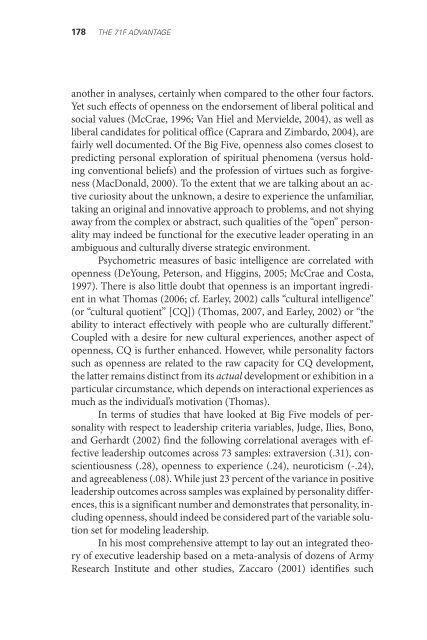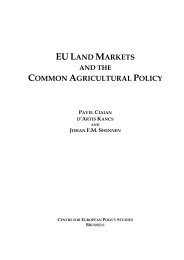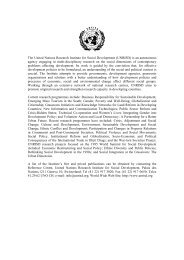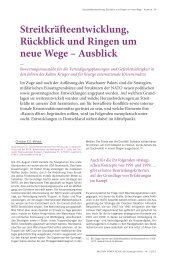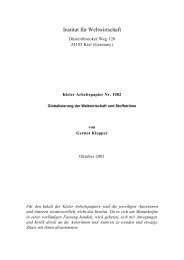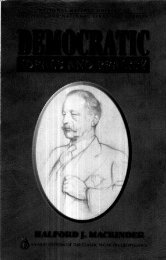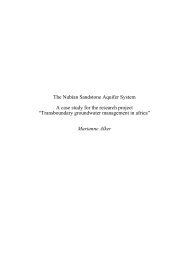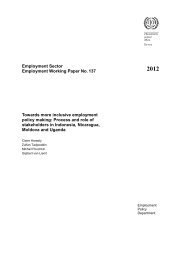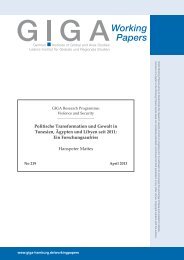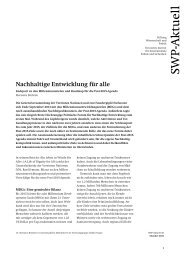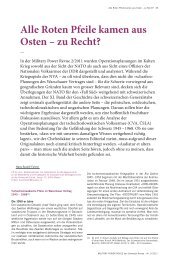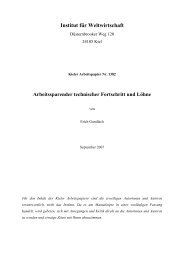Understanding and Measuring Creative Thinking in Leaders
Understanding and Measuring Creative Thinking in Leaders
Understanding and Measuring Creative Thinking in Leaders
Create successful ePaper yourself
Turn your PDF publications into a flip-book with our unique Google optimized e-Paper software.
178 THE 71F ADVANTAGEanother <strong>in</strong> analyses, certa<strong>in</strong>ly when compared to the other four factors.Yet such effects of openness on the endorsement of liberal political <strong>and</strong>social values (McCrae, 1996; Van Hiel <strong>and</strong> Mervielde, 2004), as well asliberal c<strong>and</strong>idates for political office (Caprara <strong>and</strong> Zimbardo, 2004), arefairly well documented. Of the Big Five, openness also comes closest topredict<strong>in</strong>g personal exploration of spiritual phenomena (versus hold<strong>in</strong>gconventional beliefs) <strong>and</strong> the profession of virtues such as forgiveness(MacDonald, 2000). To the extent that we are talk<strong>in</strong>g about an activecuriosity about the unknown, a desire to experience the unfamiliar,tak<strong>in</strong>g an orig<strong>in</strong>al <strong>and</strong> <strong>in</strong>novative approach to problems, <strong>and</strong> not shy<strong>in</strong>gaway from the complex or abstract, such qualities of the “open” personalitymay <strong>in</strong>deed be functional for the executive leader operat<strong>in</strong>g <strong>in</strong> anambiguous <strong>and</strong> culturally diverse strategic environment.Psychometric measures of basic <strong>in</strong>telligence are correlated withopenness (DeYoung, Peterson, <strong>and</strong> Higg<strong>in</strong>s, 2005; McCrae <strong>and</strong> Costa,1997). There is also little doubt that openness is an important <strong>in</strong>gredient<strong>in</strong> what Thomas (2006; cf. Earley, 2002) calls “cultural <strong>in</strong>telligence”(or “cultural quotient” [CQ]) (Thomas, 2007, <strong>and</strong> Earley, 2002) or “theability to <strong>in</strong>teract effectively with people who are culturally different.”Coupled with a desire for new cultural experiences, another aspect ofopenness, CQ is further enhanced. However, while personality factorssuch as openness are related to the raw capacity for CQ development,the latter rema<strong>in</strong>s dist<strong>in</strong>ct from its actual development or exhibition <strong>in</strong> aparticular circumstance, which depends on <strong>in</strong>teractional experiences asmuch as the <strong>in</strong>dividual’s motivation (Thomas).In terms of studies that have looked at Big Five models of personalitywith respect to leadership criteria variables, Judge, Ilies, Bono,<strong>and</strong> Gerhardt (2002) f<strong>in</strong>d the follow<strong>in</strong>g correlational averages with effectiveleadership outcomes across 73 samples: extraversion (.31), conscientiousness(.28), openness to experience (.24), neuroticism (-.24),<strong>and</strong> agreeableness (.08). While just 23 percent of the variance <strong>in</strong> positiveleadership outcomes across samples was expla<strong>in</strong>ed by personality differences,this is a significant number <strong>and</strong> demonstrates that personality, <strong>in</strong>clud<strong>in</strong>gopenness, should <strong>in</strong>deed be considered part of the variable solutionset for model<strong>in</strong>g leadership.In his most comprehensive attempt to lay out an <strong>in</strong>tegrated theoryof executive leadership based on a meta-analysis of dozens of ArmyResearch Institute <strong>and</strong> other studies, Zaccaro (2001) identifies such


